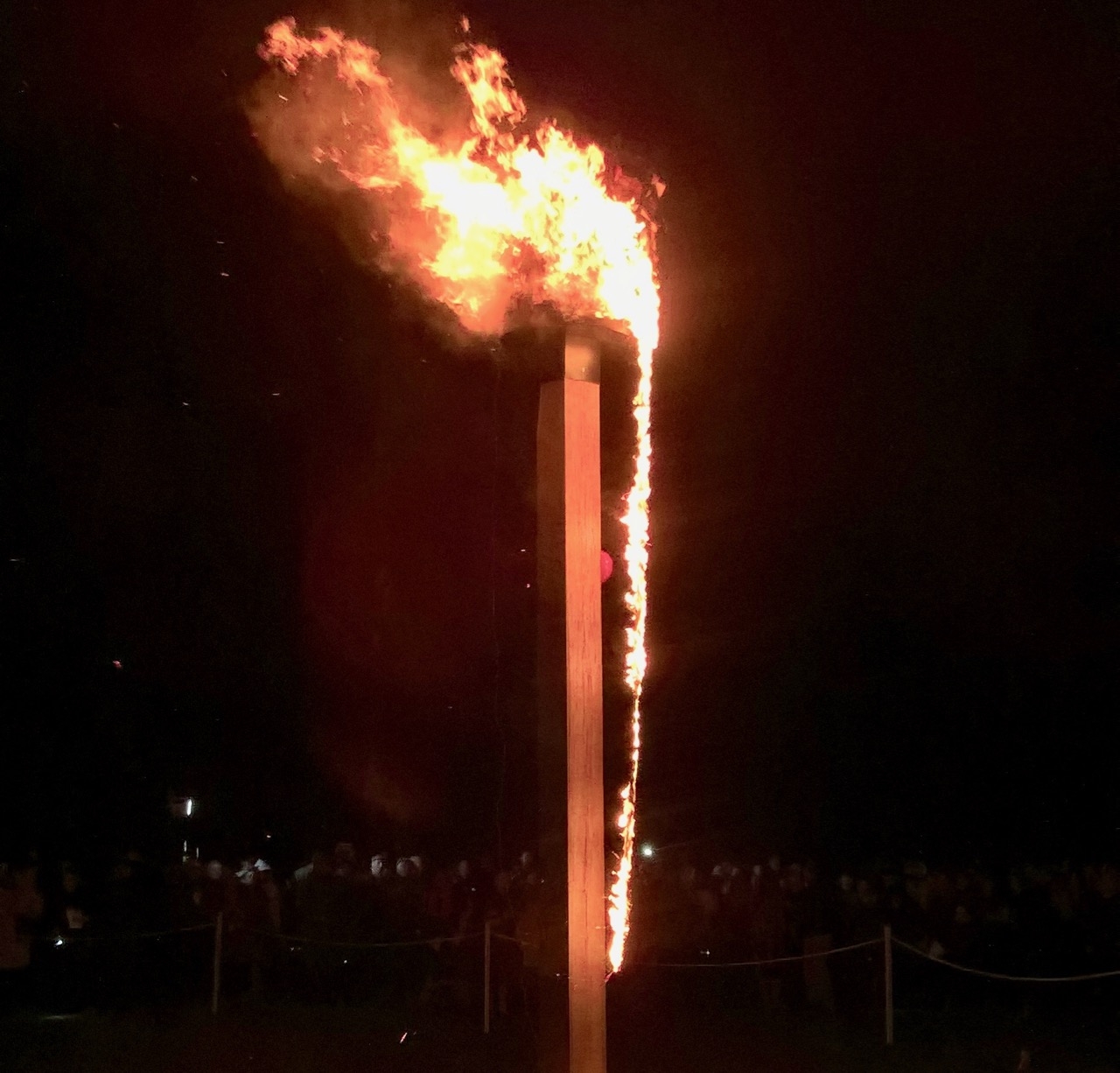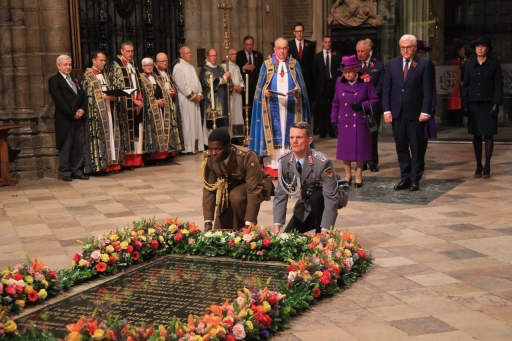Patrick Gregory on how Armistice Day 2018 was commemorated across the length and breadth of Britain and Ireland.
As was fitting for this, the centenary of the Armistice, the ceremonies and commemorations marking the end of World War 1 in the British Isles were on a different scale than previous years. They were also of a different nature, coming in many guises, from the sober and formal ceremonies to the more community based and artistic endeavours.
It was a time to remember and to reflect on the conflict that ended a century before. The ferocity of the war, yes. The sacrifice and the loss suffered and the change it wrought afterwards. But there was also a conscious shift in emphasis to try to reach an ever wider public, and, in so doing, passing it on to younger generations.
 The traditional ceremony in Whitehall: Designed by Sir Edwin Lutyens as Britain’s national memorial to the dead of the First World War, the Cenotaph is also the focus for remembrance of both World Wars and subsequent conflicts (Photo © DCMS – UK Government)
The traditional ceremony in Whitehall: Designed by Sir Edwin Lutyens as Britain’s national memorial to the dead of the First World War, the Cenotaph is also the focus for remembrance of both World Wars and subsequent conflicts (Photo © DCMS – UK Government)
At 1100 on Sunday morning, just as the guns fell silent at the 11th hour of the eleventh month 100 years ago, silence settled on Britain. Two minutes of silence at cenotaphs up and down the country were observed. In public buildings and spaces, at airports and railway stations, on television and radio stations, people shared the moment.
The Queen was in London, watching from a balcony overlooking the Cenotaph as the country’s main service got underway in Whitehall. Prince Charles laid a wreath on her behalf, joined by political leaders including Prime Minister Theresa May and Labour leader Jeremy Corbyn and the German President Frank-Walter Steinmeier, the first German leader to take part in such a ceremony.
Ten thousand people, including veterans and relatives of WW1 soldiers, marched past later, part of a “People’s Procession”. In their midst, and among the oldest taking part, were Private Donald Smith, 98, who joined current members of the Queen’s Own Highlanders, and Jeff Watkins, 97, who had travelled from California to take part.
 Some of the many wreaths laid at the Cenotaph, commemorating both individuals and the sacrifice of the Commonwealth nations (Photo: Centenary News)
Some of the many wreaths laid at the Cenotaph, commemorating both individuals and the sacrifice of the Commonwealth nations (Photo: Centenary News)
Remembrance services took place throughout the two islands of Great Britain and Ireland: in Wales at Llandaff Cathedral in Cardiff, in Scotland at Glasgow Cathedral and in Northern Ireland at St Anne’s Cathedral in Belfast; and in the Irish Republic, where for many decades it was a very different story, with the role of Irish soldiers in the war not as publicly acknowledged, ceremonies took place in Dublin, Cork, Limerick, and other towns and cities.
‘Pages of the Sea’
Away from these set-piece events, artistic endeavours were underway around the islands’ shores with film and theatre director Danny Boyle coordinating efforts to have images of WW1 soldiers etched into the sand at 32 chosen beaches.

The war poet Wilfred Owen, commemorated on Sunny Sands Beach, Folkestone (Image © courtesy of 14-18 NOW )
Pages of the Sea, an initiative sponsored by the UK’s commemorative umbrella organisation 14-18 NOW, brought together artists and volunteers to trace the silhouettes of Great War soldiers and the faces of specific named servicemen. One such was that of poet Wilfred Owen, killed exactly one week before the Armistice in 1918, carved into the sand at Folkestone on England’s south coast, embarkation point for so many going to Europe to serve during the war.
They gathered at the base of the Armed Forces Memorial at the National Arboretum in Staffordshire; in Wiltshire, guns sounded over Salisbury Plain for a salute near Stonehenge; in Newhaven, the Bishop of Lewes arrived on motorbike with the Royal British Legion riders’ branch; in Cheshire, 100,000 poppy petals fell from the top of the Anderton Boat Lift to remember the watermen who moved troops and cargo via Britain’s canal system. In all, most of the 100,000 war memorials up and down the land witnessed some form or other of ceremony.
Sunday’s events were rounded off by a formal Service of Remembrance at Westminster Abbey, members of the Royal Family again in attendance with politicians and visiting dignitaries. The Queen laid flowers at the grave of the Unknown Warrior, whose body was brought back from France in 1920.
The Archbishop of Canterbury, Justin Welby, spoke of his hope that the peace which had eluded Europe and the world in the aftermath of 1918 could yet be achieved. “The great cry was of a war to end all wars”, he said. Idealistic dreams had been squandered at that time: “Slowly killed – destroyed by dictatorships, isolationism, a turning inwards by the strong and the manipulations of the ruthless”. But, he continued: “The final verdict on evil is defeat. The final call from human beings from the God we worship here today is hope, life and liberation”.
 The beacon tribute at Long Melford in Suffolk (Photo courtesy of John Nunn)
The beacon tribute at Long Melford in Suffolk (Photo courtesy of John Nunn)
Outside the Abbey a beacon was lit, one of 1,000 “Beacons of Light” being lit up and down the country: communities of people coming together in towns and villages to mark the peace that emerged from the darkness of four years of war. A final act of tribute to the fallen of 1914-1918.
Images © – courtesy of Dean and Chapter of Westminster Abbey (Her Majesty the Queen and President Frank-Walter Steinmeier); Department for Digital, Culture, Media & Sport – Flickr, Creative Commons, CC BY-NC-ND 2.0 (Cenotaph ceremony); 14-18 NOW (Wilfred Owen sand drawing, Folkestone); John Nunn (Long Melford beacon); and Centenary News (Cenotaph wreaths)
See also in Centenary News, our reports from the Armistice Day events in Mons:
Belgium & Canada honour George Price, the last Commonwealth soldier killed in action in WW1, with opening of new memorial.
Tributes at St Symphorien, CWGC cemetery where the fallen of August 1914 and November 1918 rest together.
Posted by: CN Editorial Team
